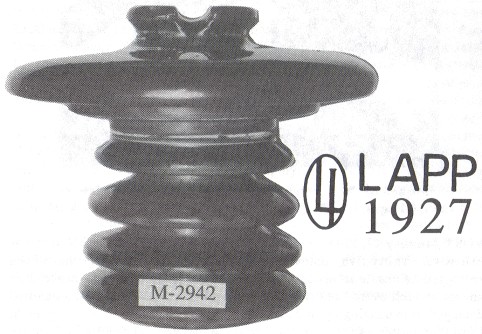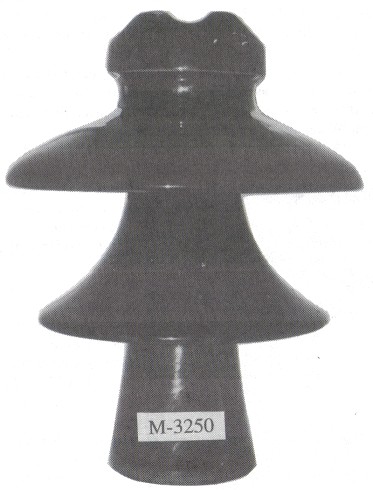Porcelain Insulator News
by Elton Gish
Reprinted from "Crown Jewels of the Wire", May 1994, page 14
We first reported an unusual fog-type insulator in the August 1989 issue of
Crown Jewels of the Wire that Chris Hedges (NIA #15) had spotted on an
unidentified bridge. Chris sent three photographs showing these insulators atop
a bridge. A photograph of this same insulator was shown in the December 3, 1927 Electrical World and identified it as having been made by
the Lapp Insulator Co. The insulators atop the bridge had been out of service
for some time. They were called into service again last year after some of the
power lines in the area were forced out of service due to flooding of the
Mississippi River. Unfortunately when the power was turned on, many of the
insulators exploded. Chris managed to recover a couple of these Lapp insulators
when they were changed out. The glaze color is the beautiful Lapp orange. They
were marked with the underglaze ink marking shown. I assigned this new multipart
style M-2942. The dimensions are 12 - 7.5 x 10. Note in the photograph that the bottom section tapers upward making the upper most
horizontal petticoat 6-1/2 inches in diameter.

Chris also reported another very
interesting multipart -- M-3250. Yes, a specimen of this historic insulator has
finally been found. In fact, three were recovered by Rob Lloyd (NIA #3414).
Chris managed to get two of the three specimens. One is very dark to nearly black and the other shown in the photograph
is a beautiful reddish mahogany color with some mustard colored areas. This
glaze color is typical of Thomas manufacture before 1910. Photographs in trade
journals show M-3250's with a white glaze. In the July 1992 issue of Crown
Jewels of the Wire, we reported pieces of a white M-3250 that were found in a
dump by Ken Willick (NIA #3709), Steve Jones, and Bob Berry (NIA #1203). Chris'
specimens match closely with the dimensions that were obtained from trade
journals when M-3250 was assigned.

Dimensions of the specimen: 10 - 8-1/4 - 4-3/8 x 13-1/4
Original M-3250
dimensions: 10 - 9 - 4 x 13.5
M-3250's were used by the Shawinigan Water
& Power Co. on their 84-mile line from Shawinigan Falls to Montreal. The line was put into service on February 3, 1903 at 50,000 volts. The bottom
skirt of this insulator is very long and required a large amount of Portland
cement to secure it inside the middle skirt. M-3250's probably experienced a
large failure rate where the porcelain shells would break due to the expansion
of the cement. The three specimens survived primarily due to their use inside a
building on the Montreal terminus of the line which offered them protection from
temperature changes. These brown specimens may have been made after the
Shawinigan line was put into service. Brown was the preferred glaze color after
about 1903. It is interesting to note that these large insulators were mounted
on a one-inch pin. Chris says that sulfur was poured in the pinhole after the
insulator was screwed onto the pin.

We last reported a turquoise blue M-2636 in
the August 1991 issue of Crown Jewels of the Wire. This was the fourth one
reported. These beautiful insulators were probably made by the Lima Insulator
Co. during the short time that they were in operation between 1904 and September
1908. I just attended the 3rd annual Metroplex Insulator Show (at Grapevine
between Ft. Worth and Dallas) which was a super show. When I was bringing a heavy box of insulators to my table,
I nearly got a hernia when I spotted a turquoise blue M-2636 sitting on the
corner of Ross Baird's (NIA #1983) table!! I knew Bob Berry (NIA #1203) and
Jimmy Burns (NIA #4032) had already beat me to the show, but there it was still
sitting on Ross' table! You can well imagine my haste at dropping the box and
cornering Ross to make the deal of the year. Curses! Ross just brought it for
"show". This one makes five of these turquoise jewels! Ross said his
came from Colorado, but the other four specimens were found in the northwest. I
would dearly like to have a second one to add to my collection, but maybe Ross'
insulator will eventually make another porcelain collector happy, too.
FRED. M. LOCKE
Many of you know that Fred M. Locke was the "Father of Porcelain
Insulators". He had glass and porcelain insulators made to his designs by
other companies and developed the first high voltage porcelain insulator. Do you
know when he started having insulators made to his design, who made them, and
when and how he started making his own insulators? Who made the underglaze ink
marked insulators and when (and why) were they made? You may be surprised to learn that it wasn't Imperial. When did he
retire (not 1903) and why? We now know why Fred sold his factory, exactly how
much he was paid, the terms of his continued employment, why he left Locke, the
date he "retired", and what he did with much of the last 26 years of
his life. I have been researching the life of Fred M. Locke for the past four
years and have uncovered all new information about this fascinating man. Much of
what we "knew" about Fred Locke was either not true or only part of
the story. So much new information has been discovered that I felt compelled to
write a biography of Fred Locke. The truth behind the legends has been found.
I
have written a book titled Fred M. Locke - A Biography which should become
available by June. It will not be a small token record of the life of Fred
Locke. The 300 or so pages will contain more than 260 old photographs, trade
journal illustrations, advertisements, etc. Almost all of the old photographs
have never been seen before in the hobby. They include many views of the early
Locke and Lima factories, glass and porcelain insulators based on Fred's patents
from 1896 to 1920, and family photos from 1870's to 1930. Fred's connection with
Corning Glass Works and the Fry Glass Co. will be discussed in detail based on
all new surprising evidence. Do you know what glass formula Fry used to make their rare
insulators, and who made glass insulators for Fred during the 1910's? Did you
know that Fred's greatest accomplishment was not the manufacture of porcelain
insulators? Several "new" Fred Locke patents have been discovered
which bring the total number of his patents to 61, and several Canadian patents
were granted, too. Each patent will be discussed in detail. All will be revealed
in my book.
More information has been discovered regarding the Thomas / Boch law
suits with Fred Locke, and several other law suits involving Fred have been
discovered. Some of them relate the details of Fred's early partnership, why he
discontinued buying insulators from Imperial, why he sold the insulator factory, why he left Locke, how he was
involved with the Lima Insulator Co., how he was involved with the Fry Glass
Co., and what interests he had that were not related to insulators.
The book
manuscript should be in the hands of the printer by April 15. The book will be
published with a soft cover; however, a very limited supply of hardbound books
will be available for those who prefer a more permanent addition to your
library. Details regarding price and date the book will be available will be
announced later. Purchasers of my multipart book will receive advanced notice in
the mail. The book will be on sale at the Houston "Silver Anniversary"
National Insulator Show on July 1-2-3. Hope to see you there!
| 